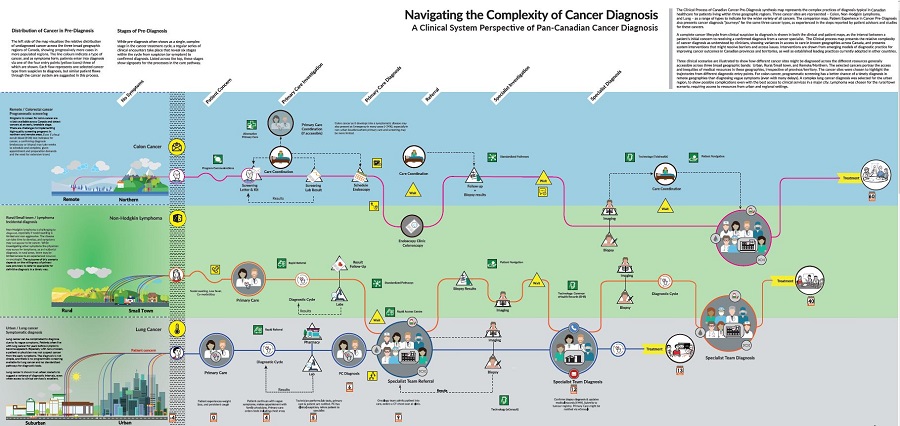Overview of patient and clinician synthesis maps
January 15, 2020
Learn about four maps highlighting real-world complexities and opportunities to improve cancer screening and diagnosis from both clinicians’ and patients’ perspectives
In cancer care, the pre-diagnosis phase is a critical part of a person’s experience. Waiting for a screening test result or the discovery of a suspicious symptom to the time of a confirmed diagnosis can be a difficult and stressful time. The recently released Canadian Strategy for Cancer Control (the Strategy) calls for a seamless, timely and integrated system that can provide more comprehensive person-centred care.
In alignment with the Strategy, the Partnership, in collaboration with OCAD University’s Health Design team, created a suite of synthesis maps to:
- understand experiences in screening and early diagnosis from both patients and clinicians’ perspectives
- facilitate opportunities to support an integrated and person-centred system that is responsive to the needs and preferences of patients and their families.
Below are links to the maps, which were informed by literature reviews and interviews with patients, clinicians and health system administrators, including leaders with responsibility for delivering screening programs:
- Patient synthesis map about breast cancer screening
- Patient synthesis map about colorectal cancer screening
- Patient synthesis map about cancer diagnosis
- Clinician synthesis map about cancer diagnosis

Through a visual translation exercise, the maps present comparison of patient and clinician perspectives to highlight the experiential differences in the pre-diagnosis care processes, including screening. They also reveal variability of access to care and inequalities across geographies and explore future interventions. For example, the geographical model of healthcare access is presented to highlight structural inequities of care due to limitations of service provision in non-urban regions.
Together, these synthesis maps illustrate the gaps in the healthcare system that can be addressed to support a seamless patient experience and enhance opportunities for early diagnosis. The maps show how to incorporate patients’ and families’ needs and preferences, and how to improve communication between patients and healthcare providers as well as between providers.
Downloadable content
File size 5 MB
File size 2 MB
File size 71 MB
File size 12 MB
